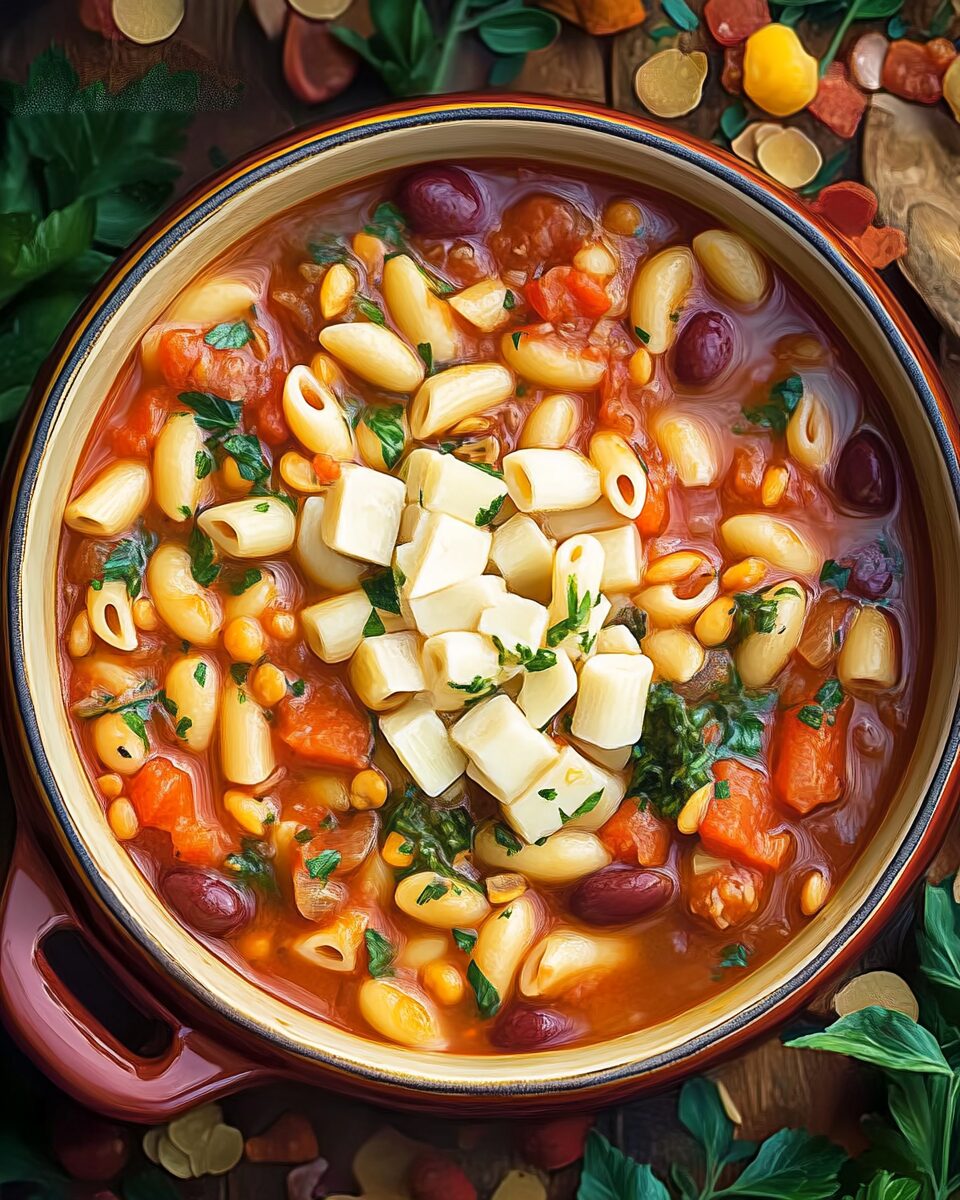The rich, savory aroma of garlic, herbs, and tomatoes fills the kitchen as this Pasta e Fagioli simmers gently on the stove. Every spoonful of this traditional Italian soup brings together soft ditalini pasta, hearty beans, and aromatic vegetables in a broth that comforts and satisfies.
This timeless dish, beloved from Naples to New York, proves that simple ingredients can create extraordinary meals. Whether you’re enjoying it freshly made or thickened as leftovers the next day, Pasta e Fagioli is a nourishing bowl of comfort that’s easy to prepare and endlessly adaptable.
Full Recipe:
-
3 tablespoons extra virgin olive oil
-
1 cup chopped onion
-
1 large carrot, peeled and chopped
-
1 large celery rib, chopped
-
2 large cloves garlic, minced
-
1/4 teaspoon chili flakes
-
1 teaspoon Italian seasoning
-
6 cups chicken stock (or vegetable stock for vegetarian option)
-
1 cup peeled tomatoes, fresh or canned
-
1/2 pound ditalini pasta
-
2 (15-ounce) cans cannellini or borlotti beans, drained and rinsed
-
1/4 cup chopped parsley
-
Kosher salt and freshly ground black pepper, to taste
Directions:
-
Heat olive oil in a large pot over medium-high heat.
-
Sauté onion, carrot, and celery for 2–3 minutes until soft and translucent.
-
Add garlic, chili flakes, and Italian seasoning. Sauté for another minute.
-
Pour in chicken or vegetable stock and add the tomatoes. Bring to a boil.
-
Add pasta and maintain a strong simmer until pasta is al dente.
-
Stir in the beans and cook for 2–3 more minutes.
-
Turn off the heat, stir in fresh parsley, and season with salt and pepper to taste.
Prep Time: 10 minutes | Cooking Time: 25 minutes | Total Time: 35 minutes
Kcal: 398 kcal | Servings: 4–6 servings
The Warm Embrace of Italian Comfort: Pasta e Fagioli
Few dishes capture the heart of Italian home cooking quite like Pasta e Fagioli. Also known as “pasta fazool” in the Italian-American lexicon, this humble soup is rooted in centuries of peasant cuisine, where necessity gave birth to some of the most cherished culinary traditions. With its medley of beans, pasta, aromatics, and broth, this dish exemplifies how simple ingredients can yield soul-warming results.
Originating from Central and Southern Italy, Pasta e Fagioli was never meant to be extravagant. Instead, it was created to stretch limited resources into something hearty and nourishing. Over time, it gained prestige far beyond its humble beginnings, earning a regular spot not only in home kitchens but also on the menus of Italian restaurants across the globe.
A Dish with a Thousand Faces
What makes Pasta e Fagioli so special is its incredible adaptability. There is no singular “correct” way to prepare it—each region of Italy, and indeed each household, boasts its own version. Some renditions are more soup-like with a brothier consistency, while others resemble a thick stew. The choice of beans may vary—cannellini, borlotti, or even kidney beans—just as the pasta can be anything from ditalini to elbow macaroni or broken spaghetti.
The presence (or absence) of tomato is another point of variation. In Tuscany, you might find a tomato-rich base, while in other areas, it may be a more golden, oil-based broth. Some recipes call for pancetta or prosciutto for added depth, but it’s just as common to find meatless versions, especially during times of fasting or for vegetarian households.
The common thread through all these versions is comfort: a bowl of Pasta e Fagioli is meant to soothe, to warm, and to nourish. It is, in many ways, Italy’s answer to chicken noodle soup—deeply personal and endlessly customizable.
Cultural Roots and Traditions
In Italian cuisine, the phrase “cucina povera”—literally, “poor kitchen”—refers to the traditional cooking of the rural population, where frugality was key. Pasta e Fagioli stands as a perfect example of this philosophy. Beans were cheap, filling, and packed with protein, making them ideal for feeding large families. Pasta, another inexpensive staple, extended the dish’s reach even further.
Despite its simple origins, the dish embodies the Italian ethos of making every ingredient count. Fresh parsley, a drizzle of olive oil, and perhaps a sprinkle of Parmigiano-Reggiano elevate this humble dish into something truly memorable. These finishing touches, though small, are treated with reverence in the Italian kitchen, which prizes balance and respect for each component.
Interestingly, Pasta e Fagioli has also crossed cultural lines to become a cherished comfort food among Italian-American communities. Immigrants brought the recipe with them to the United States, where it was embraced and evolved. The Americanized version, often called “pasta fazool,” remains a staple in many Northeastern households to this day, especially in cities like New York and Philadelphia.
Nutritional and Practical Benefits
One of the reasons Pasta e Fagioli remains such a beloved dish is that it’s as practical as it is delicious. Beans are an excellent source of plant-based protein and fiber, while the vegetables provide essential vitamins and minerals. Pasta contributes energy-rich carbohydrates, making this a well-rounded meal in a single bowl.
For home cooks, the soup offers great flexibility. It can be made in large batches, stores well in the fridge for a few days, and even thickens over time, often tasting better the next day. That said, it doesn’t freeze particularly well with the pasta already added, since the pasta tends to absorb too much liquid and break down in texture. To get around this, some cooks choose to cook the pasta separately and combine it only when serving—especially if they plan to freeze the soup.
Pasta e Fagioli also lends itself beautifully to dietary customization. For vegetarians, vegetable stock can easily replace chicken broth. Vegans can omit cheese, and those with gluten sensitivities can substitute gluten-free pasta. The adaptable nature of the recipe makes it inclusive and approachable for a wide range of dietary needs.
Serving and Pairing Suggestions
Pasta e Fagioli is typically served hot, garnished with freshly chopped parsley, a drizzle of extra virgin olive oil, and a healthy shaving of Parmigiano-Reggiano or Pecorino Romano cheese. It pairs wonderfully with crusty Italian bread or focaccia, perfect for mopping up the savory broth.
A glass of medium-bodied red wine, such as Chianti or Barbera, complements the earthy flavors of the beans and the gentle acidity of the tomatoes. For a non-alcoholic pairing, sparkling water with a slice of lemon offers a refreshing contrast to the soup’s richness.
If serving Pasta e Fagioli as part of a larger Italian meal, it often acts as the primo (first course), followed by a simple meat or vegetable-based secondo. However, thanks to its heartiness, it can easily stand alone as a satisfying one-pot dinner.
Seasonal and Regional Timing
Although Pasta e Fagioli can be enjoyed year-round, it is particularly comforting in the colder months. Fall and winter are ideal seasons to make this dish, when root vegetables are plentiful and a warm bowl of soup feels like a necessity rather than a luxury.
In rural Italian regions, this dish might also mark the beginning of the bean harvesting season. Freshly shelled borlotti beans, when in season, bring an unmatched creaminess to the soup that is hard to replicate with canned alternatives.
Tips for Success
While the recipe itself is straightforward, a few tips can help elevate your Pasta e Fagioli from good to unforgettable:
-
Use high-quality stock: Whether chicken or vegetable, the stock forms the base of your flavor, so use homemade or a good-quality store-bought version.
-
Sauté aromatics well: Letting the onion, garlic, carrot, and celery develop a slight caramelization adds depth to the soup.
-
Don’t overcook the pasta: If the soup will be eaten later, cook the pasta separately and combine just before serving to maintain the ideal texture.
-
Add cheese wisely: Stirring cheese directly into the soup can dull its flavor. Instead, offer grated cheese at the table for diners to add as they wish.
-
Finish with olive oil: A drizzle of extra virgin olive oil right before serving enhances flavor and adds a luxurious mouthfeel.
Conclusion: Tradition in Every Spoonful
Pasta e Fagioli is more than a meal—it’s a symbol of resilience, family, and tradition. In a world that often chases the newest trends and gourmet ingredients, this dish reminds us that some of the most memorable meals come from modest origins. Its versatility, warmth, and richness have allowed it to endure through generations, kitchens, and continents.
Whether you’re craving comfort, feeding a crowd, or looking for a nutritious meal with pantry staples, Pasta e Fagioli delivers. Each spoonful tells a story—of a grandmother in Southern Italy stirring a pot with love, of immigrant families keeping heritage alive in a new land, and of the timeless power of food to bring people together.
So the next time you need a bit of culinary solace, let Pasta e Fagioli do what it’s done for centuries: fill your bowl, warm your heart, and nourish your soul.






